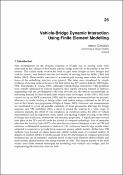Options
Vehicle-bridge dynamic interaction using finite element modelling
Author(s)
Date Issued
2010-08-17
Date Available
2019-04-29T09:29:25Z
Abstract
First investigations on the dynamic response of bridges due to moving loads were motivated by the collapse of the Chester railway bridge in the UK in the middle of the 19th century. This failure made evident the need to gain some insight on how bridges and vehicles interact, and derived into the first models of moving loads by Willis (1849) and Stokes (1849). These models consisted of a concentrated moving mass where the inertial forces of the underlying structure were ignored. The latter were introduced for simple problems of moving loads on beams in the first half of the 20th century (Jeffcott, 1929; Inglis, 1934; Timoshenko & Young, 1955). Although Vehicle-Bridge Interaction (VBI) problems were initially addressed by railway engineers, they rapidly attracted interest in highway engineering with the development of the road network and the need to accommodate an increasing demand for heavier and faster vehicle loads on bridges. In the 1920’s, field tests carried out by an ASCE committee (1931) laid the basis for recommendations on dynamic allowance for traffic loading in bridge codes, and further testing continued in the 50’s as part of the Ontario test programme (Wright & Green, 1963). However, site measurements are insufficient to cover all possible variations of those parameters affecting the bridge response, and VBI modelling offers a mean to extend the analysis to a wide range of scenarios (namely, the effect of road roughness or expansion joints, the effect of vehicle characteristics such as suspension, tyres, speed, axle spacing, weights, braking, or the effect of bridge structural form, dimensions and dynamic properties). A significant step forward took place in the 50’s and 60’s with the advent of computer technology. It is of particular relevance the work by Frýba (1972), who provides an extensive literature review on VBI and solutions to differential equations of motion of 1-D continuous beam bridge models when subjected to a constant or periodic force, mass and sprung vehicle models. At that time, VBI methods were focused on planar beam and vehicle models made of a limited number of degrees of freedom (DOFs). From the decade of the 70’s, the increase in computer power has facilitated the use of numerical methods based on the Finite Element Method (FEM) and more realistic spatial models with a large number of DOFs. This chapter reports on the most widely used finite element techniques for modelling road vehicles and bridges, and for implementing the interaction between both.
Type of Material
Book Chapter
Publisher
InTech
Copyright (Published Version)
2010 the Author
Subject – LCSH
Bridges
Live loads
Mathematical models
Structural dynamics
Finite element method
Language
English
Status of Item
Peer reviewed
Journal
Moratal D. (ed.). Finite Element Analysis
ISBN
978-953-307-123-7
This item is made available under a Creative Commons License
File(s)
Loading...
Name
Gonzalez_2010_vehicle-bridge-dynamic-interaction-using-finite-element-modelling.pdf
Size
3.38 MB
Format
Adobe PDF
Checksum (MD5)
5c92afa2faf44c708a05f485d7a10aa7
Owning collection